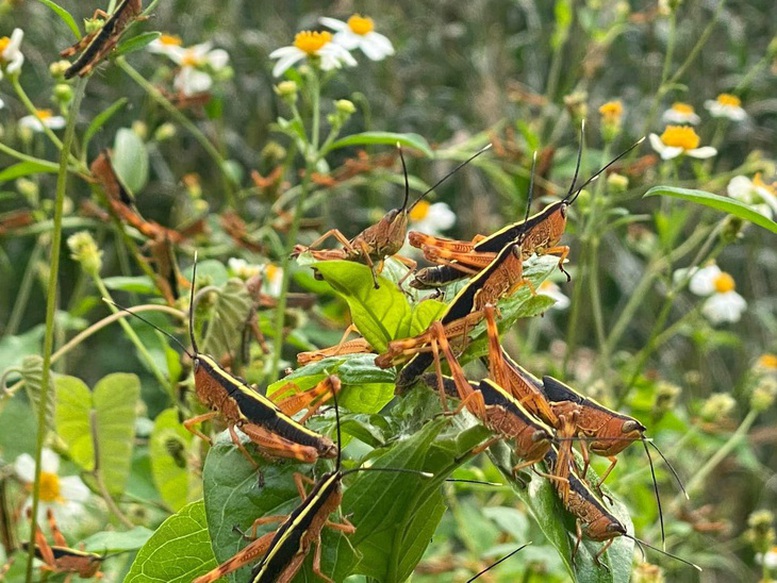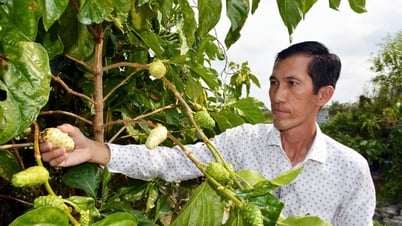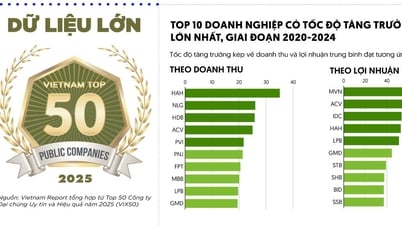
Bamboo locusts - a familiar pest that has been breaking out in the northern mountainous provinces and the North Central region since 2008
Bamboo locusts, a familiar pest, have been breaking out in the northern mountainous provinces and the North Central region since 2008. Each year, the total affected area ranges from 1,000 to 4,000 hectares, mainly on bamboo, reed, and rattan. When the density is high, they also attack upland rice, corn, tobacco, bananas, and arrowroot. In 2024, 9 provinces in the Northern Midlands and Mountains (Cao Bang, Bac Kan , Dien Bien, Lang Son, Son La, Tuyen Quang, Hoa Binh, Phu Tho) and 2 provinces in the North Central region (Thanh Hoa, Nghe An) recorded a total infected area of about 1,031 hectares.
Notably, since early June 2025, Bo Trach district (Quang Binh) has recorded for the first time an unusually high density of bamboo locusts, causing severe damage to bamboo trees in local areas. Previously, on May 22, 2025, the People's Committee of Cao Bang province announced a bamboo locust epidemic in Nguyen Binh, Hoa An and Thach An districts, mobilizing resources to control it.
The weather since early 2025 has also contributed to the development of locusts. The average temperature in the midland and mountainous areas of the North has been lower than many years (down 0.5-1°C), accompanied by light rain and prolonged drizzle. However, from mid-May 2025, intense heat returned, creating conditions for locusts to emerge earlier than in previous years.
The Department of Crop Production and Plant Protection ( Ministry of Agriculture and Environment ) has just sent an urgent dispatch to the Department of Agriculture and Environment of 12 provinces in the North and North Central region, including Cao Bang, Bac Kan, Son La, Dien Bien, Lang Son, Phu Tho, Hoa Binh, Tuyen Quang, Quang Ninh, Thanh Hoa, Nghe An and Quang Binh. The dispatch requests the synchronous implementation of measures to prevent and control bamboo locusts, which are causing serious damage to bamboo and some agricultural crops.
In many localities, bamboo forests have been severely damaged, with their leaves eaten away, affecting the livelihoods of people who depend on bamboo. In Cao Bang, after efforts to control the situation, the yellow-backed bamboo locust epidemic has been resolved, but the risk of recurrence still exists. Experts warn that if not proactively prevented, adult locusts can travel far, causing widespread damage to agricultural crops.
To limit damage, the Department of Crop Production and Plant Protection recommends that provinces implement specific measures:
Local authorities need to provide guidance on investigating and detecting locust nests when they are still young (T1-2) and spraying them promptly. Closely monitor the movement of adult locusts to organize effective control and prevent spread.
Communes that are frequently affected need to develop plans, arrange budgets, materials and human resources to be ready to respond as soon as locusts appear.
Coordinate with the media to guide forest owners and people to detect and handle locust nests early. Avoid widespread chemical spraying, causing waste and environmental pollution.
Maintain the information system, report the outbreak and development of diseases to the Department of Crop Production and Plant Protection for timely direction.
The Department of Crop Production and Plant Protection also emphasized the importance of proactiveness and close coordination between localities. With changing weather conditions and the risk of locusts spreading, the synchronous implementation of measures not only protects crops but also contributes to maintaining the ecology and livelihoods of the farming community.
Do Huong
Source: https://baochinhphu.vn/chu-dong-phong-tranh-tac-hai-cua-chau-chau-tre-den-moi-truong-102250613063747283.htm


























































































Comment (0)